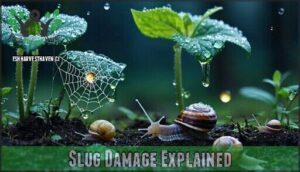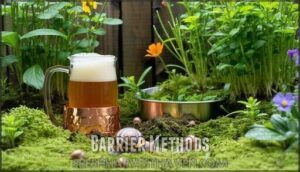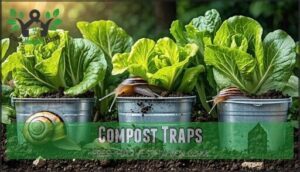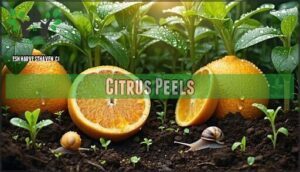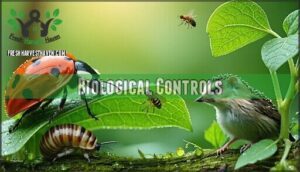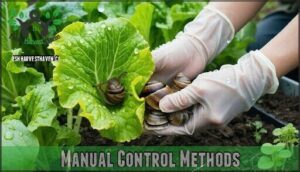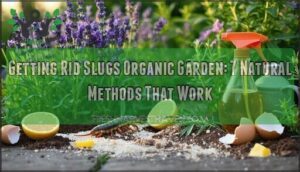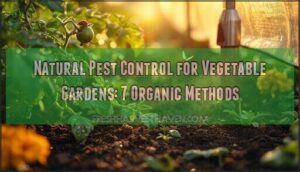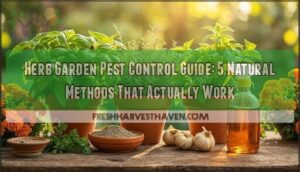This site is supported by our readers. We may earn a commission, at no cost to you, if you purchase through links.
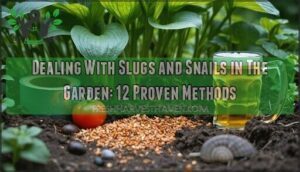
You’ll find success using barrier methods like copper tape, eggshells, or coffee grounds around vulnerable plants.
Beer traps work surprisingly well—slugs can’t resist the yeast and meet their end in the shallow dish.
Natural predators like birds and ground beetles help control populations, while hand-picking during evening hours removes adults before they reproduce.
Diatomaceous earth creates an abrasive barrier that damages their soft bodies.
The key lies in combining several methods and understanding their nocturnal habits and moisture preferences for maximum effectiveness.
Table Of Contents
- Key Takeaways
- Slug Damage Explained
- Why Control Slugs
- Natural Repellents
- Barrier Methods
- Traps and Baits
- Chemical Solutions
- Biological Controls
- Environmental Adjustments
- Manual Control Methods
- Frequently Asked Questions (FAQs)
- How do I stop slugs and snails in my garden?
- What do slugs and snails hate the most?
- Will coffee grounds keep slugs and snails away?
- Should you kill slugs in the garden?
- How to get rid of slugs and snails in your garden?
- Do slugs & snails damage garden plants?
- How do you protect plants from slugs & snails?
- How do I get slugs out of my Garden?
- How do you control slugs & snails?
- How to get rid of snails & slugs with vinegar?
- Conclusion
Key Takeaways
- Use multiple methods together – You’ll get better results by combining beer traps, copper barriers, handpicking, and natural predators rather than relying on just one approach.
- Target their hiding spots – You need to remove debris, boards, and dense plantings where slugs shelter during the day, then check your garden at night when they’re most active.
- Create uncomfortable barriers – You can protect plants by surrounding them with coffee grounds, crushed eggshells, or copper tape that slugs won’t cross due to texture or mild electrical charges.
- Control moisture and timing – You should water your garden in the morning instead of in the evening and improve drainage to make conditions less appealing to these moisture-loving pests.
Slug Damage Explained
You’ll spot slug damage by the telltale slime trails they leave behind and the distinctive round holes with jagged edges chewed through your plants.
These nocturnal pests can destroy entire seedlings overnight, leaving only stems and causing significant crop losses in your garden.
Garden Destruction
Your garden becomes a battlefield when slugs and snails launch their nighttime assault. These slimy invaders create leaf damage that devastates your plants’ health and appearance.
Slug damage appears as irregular holes throughout foliage, while snail damage leaves similar destruction plus telltale slime trails. The productivity loss affects both plant health and garden aesthetic impact.
One way to combat this is to employ nematodes for slug control.
Here’s what seedling loss and economic costs look like:
- Tender seedlings disappear completely overnight
- Mature plants suffer 30% foliage reduction weekly
- Plant damage spreads to neighboring healthy specimens
- Garden maintenance costs double from replacement needs
Plant Vulnerability
Certain plants act like magnets for slugs and snails, making Seedling Preference and Leaf Texture critical factors in your garden’s survival.
Plant Age matters most during vulnerable Growth Stage periods when tender shoots emerge.
- Hostas and delphiniums suffer severe leaf damage due to their soft, succulent leaves
- Lettuce and spinach face constant plant damage from their preferred leaf texture
- Young seedlings experience devastating snail damage before developing Species Resistance
- Strawberry plants attract slugs with their sweet leaves and accessible plant preferences
- Cabbage family crops endure repeated slug damage throughout their early growth stage
Economic Impact
Beyond destroying your prized plants, slug damage hits your wallet hard.
These garden pests cause crop losses worth billions globally, with home gardens suffering yield reductions up to 20%.
Your garden productivity drops substantially during severe infestations, turning thriving beds into expensive failures.
Control costs add up quickly.
Professional treatments, replacement plants, and ongoing pest control products strain budgets.
The market impact affects local food prices when commercial growers face similar challenges.
Some regions even impose export restrictions on affected crops.
Don’t forget tourism effects – damaged community gardens and botanical displays hurt local economies.
Your neighborhood’s property values can decline when gardens look neglected due to uncontrolled garden pests.
Slug activity often increases after they emerge from their summer underground residence, making fall a critical time for monitoring.
Smart slug control saves money long-term.
Preventative measures cost less than reactive treatments, protecting both your investment and peace of mind.
Why Control Slugs
You’ll want to control slugs before they destroy your garden and cost you money.
These pests can wipe out entire crops overnight, so taking action early protects your plants and prevents major infestations.
Protecting Crops
Several tactics protect your crops from these destructive garden pests. Resistant Varieties like foxgloves and lavender naturally deter slugs through their texture and scent. Seedling Protection proves essential since young plants face the highest risk of complete destruction.
Raised Beds improve drainage and create barriers that reduce slug populations. Companion Planting with herbs creates natural deterrents while Crop Rotation disrupts slug feeding patterns. Effective plant protection combines multiple strategies for maximum defense.
- Choose slug-resistant plants like rosemary and sage for natural deterrence
- Install physical barriers around vulnerable seedlings and tender crops
- Schedule morning watering to reduce nighttime moisture that attracts pests
- Space plants properly to improve airflow and reduce humid microclimates
- Monitor regularly for early signs of slug damage and slime trails
Introducing Predators
Natural predators work as your garden’s security team, hunting slugs and snails without chemicals or constant maintenance.
Attracting Snakes like garter snakes brings powerful allies that consume dozens of garden pests weekly.
Encouraging Birds through feeders and water sources draws thrushes, robins, and blackbirds that actively hunt these mollusks.
Decollate Snails target harmful garden snails specifically while leaving plants untouched, creating natural balance in your ecosystem.
- Ground beetles patrol at night, using powerful jaws to eliminate slugs efficiently
- Hedgehog Habitats with brush piles and native plants attract these nocturnal slug hunters
- Chicken Benefits include daily pest control plus fresh eggs from backyard flocks
Preventing Infestations
Prevention beats cure when dealing with garden slugs and snails. Start with Garden Hygiene by clearing away debris, fallen leaves, and dense plantings where these pests hide during daylight hours. Reduce Moisture by watering early morning instead of evening, allowing soil to dry before nightfall when slugs become active.
Choose Resistant Plants like lavender, rosemary, and foxgloves that naturally repel these creatures. Create Predator Habitats with birdbaths and native plants to attract beneficial birds, frogs, and ground beetles for natural pest control. A useful strategy is to apply coffee grounds repellent around vulnerable plants.
Garden Hygiene
Moisture Control
Plant Selection
Soil Quality
Early Detection through regular garden inspections helps catch problems before they multiply. These garden barriers and environmental changes form effective slug prevention and snail control strategies.
Natural Repellents
Natural repellents offer an eco-friendly way to protect your garden without harsh chemicals.
You can use everyday items like coffee grounds, seaweed, mint trimmings, and rosemary bushes to create barriers that slugs and snails naturally avoid, utilizing eco-friendly methods and everyday items.
Coffee Grounds
Your morning coffee grounds pack a double punch against slugs and snails. The caffeine effects are toxic to these pests, making coffee grounds an excellent natural deterrent around vulnerable plants.
Your morning brew becomes a garden weapon – caffeine kills slugs while feeding your plants.
Application methods are straightforward:
- Sprinkle used grounds directly around plant bases
- Create protective rings 2-3 inches from stems
- Reapply after rain or watering
- Mix with compost for extended soil benefits
Ground sourcing from local coffee shops provides free supplies for slug control and snail control. Fresh grounds contain higher caffeine levels for stronger protection, though used grounds work effectively too.
This method offers plant benefits through added nitrogen while addressing soil acidity concerns when used moderately. Coffee grounds improve drainage and attract beneficial earthworms, creating healthier garden conditions that naturally discourage slugs.
Seaweed
While coffee grounds work well, seaweed delivers even stronger slug deterrent properties through its natural salt content and rough texture.
This ocean-based solution creates an uncomfortable barrier that slugs and snails actively avoid.
Seaweed benefits extend beyond pest control. Seaweed fertilizer enriches your soil as it decomposes, while seaweed mulch retains moisture for your plants. Seaweed extracts and seaweed meal provide concentrated nutrients that boost plant health.
Apply seaweed using these organic slug control methods:
- Fresh seaweed – Spread wet kelp directly around vulnerable plants for immediate protection
- Dried seaweed – Sprinkle dehydrated seaweed as concentrated, long-lasting barriers
- Seaweed mulch layers – Create thick borders combining seaweed with other organic materials
The salt content dehydrates slugs on contact while providing valuable nutrients. Use local varieties to reduce costs, but apply moderately to prevent salt buildup.
Mint Trimings
Mint trimmings create a powerful natural barrier against slugs through their strong aromatic oils. The scent impact from fresh mint overwhelms slugs’ sensitive navigation systems, making them avoid treated areas completely.
Here’s your mint-based protection strategy:
- Scatter fresh mint clippings around vulnerable plants weekly
- Mix chopped mint leaves into soil as a soil amendment
- Create mint spray by steeping leaves in hot water
- Use companion planting with mint varieties around garden borders
- Crush leaves before spreading to maximize aromatic deterrents release
This slug repellent method offers excellent mint benefits without mint toxicity concerns for your garden. You can also deter pests by using essential oil sprays.
Rosemary Bushes
Rosemary’s needle-sharp leaves and pungent oils make this Mediterranean herb a natural slug fortress around your garden.
Different rosemary varieties offer varying aromatic properties – Spanish rosemary packs the strongest punch.
Companion planting creates protective barriers while giving you fresh herbs for culinary uses.
Beyond slug repellent benefits, rosemary provides medicinal benefits and year-round greenery.
Plant these aromatic deterrents around vulnerable crops for effective snail repellent action.
Barrier Methods
Physical barriers create tough terrain that slugs and snails can’t cross comfortably.
You’ll set up protective zones around your plants using materials that make these pests think twice about their midnight snacking plans.
Grit and Gravel
Creating gravel barriers doesn’t require fancy equipment—just the right grit size and placement strategy. You’ll want materials that create sharp, uncomfortable surfaces slugs can’t cross without injury.
Gravel types matter for effectiveness. Coarse textures work better than smooth stones since they create more discomfort for soft slug bodies. Consider drainage impact when choosing materials—some options improve soil drainage while others may compact over time.
To find the ideal material, consider the available gravel products for your specific needs. Here are five proven grit barriers:
- Crushed eggshells – Free calcium source with sharp edges
- Coarse sand – Creates uncomfortable sliding surface
- Diatomaceous earth – Food-grade powder that dehydrates slugs
- Crushed oyster shells – Long-lasting protection with excellent aesthetic appeal
- Wood ash – Alkaline barrier that works as snail repellent
Apply these materials in 2-3 inch bands around vulnerable plants. This slug bait alternative works through physical deterrence rather than poison, ensuring plant compatibility while creating effective protection zones.
Copper Tape
While grit creates rough surfaces, copper tape offers an electrical approach to slug control.
This thin metal strip generates a mild shock when slugs’ mucus contacts the copper surface. Tape effectiveness depends on creating complete barriers around pots or beds—gaps allow crossings.
Application techniques require clean, dry surfaces and minimum 3-inch widths for best results. Regular polishing maintains conductivity as oxidation reduces performance.
For those seeking copper tape products, online retailers offer various options. Cost analysis shows copper runs £2-£5 per meter, making it pricier than other copper alternatives.
Long-term use needs maintenance but provides chemical-free protection for valuable plants.
Eggshells
Copper tape might shock slugs, but crushed eggshells create a natural fortress around your plants.
These calcium-rich barriers form rough terrain that garden snails refuse to cross. The sharp edges irritate their soft undersides, making your crops untouchable.
Your breakfast waste becomes powerful slug defense while enriching soil as a calcium source. This dual-purpose soil amendment transforms kitchen scraps into effective natural methods for pest control.
- Crush shells to quarter-inch pieces – proper shell size guarantees maximum deterrent effect
- Create protective rings around vulnerable plants using consistent application methods
- Replace monthly as decomposition rate reduces barrier effectiveness over time
Fresh barriers maintain peak protection against persistent garden invaders.
Pine Needles
Around your vulnerable plants, pine needles create a natural fortress that slugs and garden snails won’t cross.
The sharp texture and pine needle acidity make this an effective barrier method that protects your crops while serving as soil amendment.
Spread a thick layer of needle mulch around affected areas.
The decomposition rate is slow, giving you months of protection.
Fresh needles work best since they maintain their sharp edges longer.
You can source pine needles from your yard or local parks.
This natural method prevents slug damage while improving soil drainage.
The needle mulch benefits extend beyond pest control, making it a smart choice for organic gardeners seeking effective barriers.
Traps and Baits
Trapping works because it uses the slug’s natural behavior against them. You’ll set up simple devices that attract these pests, then collect and dispose of them the next morning.
Beer Traps
Beer traps work around the clock to eliminate slugs and snails from your garden.
These deadly devices use fermentation volatiles to lure pests into shallow containers filled with beer. Research shows beer traps capture an average of 5-6 slugs within 3-4 days when properly maintained.
- Position traps level with soil using shallow dishes filled with 3 inches of yeasty beer
- Replace beer every 2-3 days to maintain trap effectiveness and prevent drying out
- Place multiple traps away from plants to avoid attracting more slugs to your garden beds
Beer effectiveness depends on proper trap placement and regular maintenance. This simple solution transforms slug problems into manageable pest control.
Grapefruit Halves
Transform yesterday’s citrus peels into effective snail traps and slug traps. Cut grapefruit halves create perfect grapefruit trap hideouts where garden snails and garden slugs gather overnight.
This Sustainable Slug Control method offers excellent Grapefruit Trap Longevity compared to Alternative Citrus Traps.
| Trap Setup | Results |
|---|---|
| Place rinds upside-down | Creates cool, moist shelter |
| Check each morning | Find 5-15 slugs per trap |
| Collect trapped pests | Remove before they escape |
| Reuse for 3-4 days | Citrus Trap Efficacy remains high |
Smart Trap Placement Strategy means positioning these citrus shelters near vulnerable plants where damage appears most severe.
Compost Traps
Compost ingredients like lettuce leaves and vegetable scraps make perfect slug traps. Place these alternative baits in shallow containers near your plants.
Garden snails can’t resist decomposing organic matter. Check trap placement daily for best trap effectiveness.
One key is to examine slug behavior factors, as their activity peaks in warm, humid conditions.
This maintenance frequency keeps your snail traps working while turning kitchen waste into useful compost traps for pest control.
Citrus Peels
Citrus peels work as effective slug traps while adding natural deterrents to your garden.
Garden snails and slugs seek cool, moist hiding spots, making upturned citrus rinds perfect collecting points.
These organic pest control methods use peel trap placement strategically around vulnerable plants.
Cut oranges or grapefruits in half, remove flesh, and place rinds cut-side down near affected areas.
Peel trap longevity depends on moisture levels, requiring replacement every few days.
Attractant effectiveness peaks when peels remain damp but not soggy.
- Morning collection reveals clusters of garden pests gathered under each citrus dome
- Biodegradable traps decompose naturally without leaving harmful residues in soil
- Strategic positioning around seedlings maximizes capture rates in high-activity zones
Citrus peel decomposition enriches soil while controlling slugs.
Peel biodegradability means you can compost used traps after disposal.
Replace peels every 2-3 days to maintain effectiveness as natural deterrents.
Chemical Solutions
When natural methods aren’t enough, you can turn to chemical solutions that target slugs and snails directly.
These treatments work fast and cover larger areas than most physical barriers can handle.
Vinegar Spray
When dealing with slugs and garden snails, you’ll find vinegar concentration matters for effective pest control.
Mix equal parts white vinegar and water to create this organic method that works on contact. Test plant sensitivity first by spraying a small area, as some delicate plants may suffer damage.
Apply directly to slugs you spot, but limit application frequency to avoid affecting soil pH levels.
While this natural method provides immediate results, aphids also succumb to vinegar solutions. While this natural method provides immediate results, consider vinegar alternatives like citrus-based sprays for gentler options.
Ammonia Mixture
Ammonia mixture delivers quick results against garden slugs and snails.
Mix one part household ammonia with nine parts water for proper ammonia dilution. This pest control solution kills on contact but requires careful foliar application—spray slugs directly, never plants.
Ammonia burns leaves and affects soil pH. Plant sensitivity varies, so test small areas first.
Follow best practices by applying during evening hours when slugs and snails are active for maximum effectiveness.
Diatomaceous Earth
Food grade diatomaceous earth works like nature’s security system against garden slugs and snails. This powdery fossil creates microscopic razor barriers that slice through slug bodies while causing fatal dehydration. You’ll need proper DE application around plant bases during dry conditions for maximum effectiveness.
Safety concerns require using only food grade versions – pool-grade types contain harmful chemicals. Wear masks during application since fine particles irritate lungs. DE hydration occurs when slugs contact the sharp diatoms, puncturing their soft bodies.
For those seeking to purchase, you can find food grade DE online.
Here’s your action plan:
- Ring protection – Circle vulnerable plants with thin DE layers
- Dry timing – Apply only during rainless periods for lasting power
- Fresh coverage – Reapply after rain or heavy watering sessions
- Strategic placement – Focus on slug highways and plant entry points
Reapplication frequency depends on weather – wet conditions wash away effectiveness. This organic snail control method eliminates slug damage without toxic residues, making gardens safer for families and pets.
Epsom Salts
Epsom salts offer dual benefits for garden slugs and snails control while boosting soil magnesium levels.
Sprinkle these crystals around plants during evening hours when pests are most active. The salt concentration effects create uncomfortable conditions that deter slugs and snails from crossing treated areas.
However, monitor application best practices carefully—excessive use can harm plant-specific reactions and disrupt soil chemistry. This pest control method works effectively alongside other strategies.
Biological Controls
Nature provides powerful allies in your fight against garden slugs and snails. These biological controls work around the clock to reduce pest populations without harming your plants or the environment.
Nematodes
When soil warming begins in spring, nematodes become your underground allies against garden snails and slugs.
These microscopic warriors use Nematode Application techniques to deliver targeted pest management without collateral damage.
Nematode Species like Phasmarhabditis hermaphrodita provide sustainable control through natural methods, killing pests within days while protecting beneficial insects and wildlife.
Copper Barriers
Around your garden beds, copper barriers act like a security fence against garden snails and slugs.
Install copper tape or foil strips around vulnerable plants—the metal creates mild electrical charges when slug slime makes contact.
Copper effectiveness depends on proper installation techniques and barrier maintenance. Check for gaps regularly, as slugs find creative detours.
While long-term costs exceed other methods, copper alternatives like mesh provide lasting pest management. This reliable system protects plants without chemicals, offering a reliable system and using copper alternatives.
Microscopic Organisms
Nematodes hunt slugs like microscopic bloodhounds, infecting them with deadly bacteria. These Soil Microbes create Microbe Symbiosis while supporting Fungal Control through natural balance. Various Nematode Species cause Bacterial Infections that eliminate slugs within days, working alongside natural predators for thorough pest management.
- Apply nematodes to warm, moist soil during spring and late summer seasons
- Water the treated area immediately after application to activate these beneficial organisms
- Expect six weeks of protection as nematodes establish colonies in your garden
- Combine with diatomaceous earth for added slug deterrence through microscopic sharp edges
- Monitor soil temperature since nematodes work best when ground reaches 55°F consistently
Environmental Adjustments
You can make your garden less hospitable to slugs and snails by adjusting your watering schedule and removing their favorite hiding spots.
These simple changes to your garden environment will discourage these pests from settling in while helping your plants thrive.
You can implement these adjustments to create a more balanced ecosystem, which will be less favorable to slugs and snails.
Watering Schedule
Your watering schedule can make or break your slug battle. Morning vs. Evening timing matters more than you think – water between 6-9 AM to let soil surfaces dry before slugs emerge.
Smart moisture management creates hostile conditions for these pests:
- Morning watering reduces evening watering appeal by lowering soil moisture levels
- Drainage considerations prevent waterlogged areas where garden snails thrive
- Plant specific needs guide timing – some require drought resistance strategies
- Moisture control through proper scheduling eliminates slug-friendly environments
This approach keeps plants healthy while removing the damp conditions slugs need to survive and reproduce in your garden.
Wood Ash
Wood ash serves as nature’s slug deterrent, creating uncomfortable barriers that dehydrate these pests on contact.
The ash composition raises soil pH levels, so apply thin layers around vulnerable plants.
Avoid heavy application methods since excessive use can cause plant toxicity.
Alternative ashes from hardwood work best.
This natural methods approach complements other garden care strategies without harmful snail bait chemicals.
Handpicking
Handpicking offers direct control over garden snails and slugs through targeted manual removal.
Conduct nightly patrols with gloves and flashlight when these pests are most active. Slug identification becomes easier in darkness as they emerge to feed.
Focus on efficient collection around vulnerable plants. Hand removal provides immediate population impact.
Choose humane disposal methods like relocating collected slugs to wooded areas away from your garden beds.
Habitat Modification
Making your garden less welcoming starts with changing the environment slugs love. After handpicking removes visible pests, focus on long-term habitat changes that prevent future infestations.
Reduce Moisture by watering early morning instead of evening. Improve Drainage around vulnerable plants to avoid waterlogged soil. Remove Debris like old boards, rocks, and leaf piles where slugs hide during daylight hours. Limit Hiding spots by maintaining a tidy garden with proper plant spacing.
Switch thick organic mulch for drier alternatives that don’t create slug-friendly environments.
Smart habitat modification targets five key areas:
- Eliminate shelter by clearing away garden debris and unused materials
- Control water through strategic irrigation timing and drainage improvements
- Increase airflow by pruning dense vegetation and spacing plants properly
- Choose resistant plants that naturally deter slug activity
- Maintain cleanliness with regular garden cleanup and proper mulch management
These changes create an unwelcome environment that forces slugs to relocate elsewhere.
Manual Control Methods
When slugs and snails overwhelm your barriers and traps, direct action becomes necessary.
Manual control methods let you take charge of the problem by physically removing these pests from your garden space.
Night Hunts
Optimal Timing makes all the difference when handpicking snails and slugs. Grab your flashlight around 10 PM when these nocturnal pests emerge to feed. The flashlight method works best during warm, damp nights when activity peaks.
Scan plant bases, mulch, and garden edges methodically. You’ll spot their telltale slime trails gleaming under your beam. This targeted approach creates significant Population Impact – removing just twenty adults prevents thousands of eggs.
Equipment Choices matter: use a bucket for collection and wear gloves for comfort. Dispatch Methods vary, but freezing collected pests offers a humane option. Consider Relocation Ethics if moving them to wooded areas away from gardens.
Relocation
Smart relocation ethics matter when moving slugs and snails from your garden. Distance matters substantially for successful pest management – these creatures can navigate back to favorite feeding spots if you don’t transport them far enough away.
Effective relocation requires three key steps:
- Transport slugs at least 50 feet away to wooded areas or wild spaces where they won’t return
- Choose suitable habitats with natural vegetation and moisture where relocated pests can survive
- Use sealed containers during transport to prevent escape and guarantee complete removal
Relocation impact on survival rates varies, but this humane method protects your garden while maintaining ecological balance. Natural methods like slug relocation work best when combined with other control strategies for thorough pest management.
Humane Dispatch
When relocation isn’t feasible, freezing methods provide the most humane dispatch option.
Place collected slugs in a container and freeze for three hours – this causes no pain.
Drowning alternatives like soapy water work quickly too.
Avoid salt harm, which causes prolonged suffering.
These humane methods respect the creatures while protecting your garden from damage effectively.
Garden Maintenance
Proper garden maintenance creates hostile conditions for slugs and Garden snails through systematic habitat disruption. Your seasonal approach to Garden Hygiene directly impacts pest populations by removing their preferred hiding spots and breeding areas.
Smart garden maintenance transforms your space into an unwelcoming environment for these persistent pests through consistent care.
- Soil Health: Clear fallen leaves and debris where slugs shelter, improving drainage around vulnerable plants
- Plant Selection: Remove dense vegetation that creates moisture-rich microclimates these pests love
- Tool Maintenance: Keep garden tools clean and store properly to prevent accidentally transporting eggs between areas
Frequently Asked Questions (FAQs)
How do I stop slugs and snails in my garden?
Use copper tape around plants, handpick slugs at night, set beer traps, sprinkle crushed eggshells, and reduce watering to create drier conditions they’ll avoid.
What do slugs and snails hate the most?
Strangely enough, slugs hate copper most – it gives them electric shocks when their slime touches it.
They also despise gritty textures like crushed eggshells, coarse sand, and coffee grounds that irritate their soft bodies.
Will coffee grounds keep slugs and snails away?
Coffee grounds work as a mild deterrent for slugs and snails since they dislike the caffeine and rough texture.
However, they’re not foolproof – you’ll need to reapply frequently after rain, as the caffeine is washed away.
Should you kill slugs in the garden?
You don’t need to kill every slug you find.
These creatures serve important roles in the ecosystem, feeding birds and other wildlife.
Instead, try relocating them to wooded areas or compost piles where they won’t damage your plants.
How to get rid of slugs and snails in your garden?
Remove hiding places like debris and boards where slugs shelter during the day. Set beer traps, sprinkle coffee grounds around plants, and encourage natural predators like birds.
Do slugs & snails damage garden plants?
Yes, slugs and snails cause significant garden damage. They’ll munch holes in leaves, completely devour seedlings overnight, and target your prized lettuce, strawberries, and hostas with their rasping feeding style.
How do you protect plants from slugs & snails?
Like knights defending a castle, you’ll need multiple layers of protection against these slimy invaders.
Create barriers using copper tape, crushed eggshells, or sand around vulnerable plants.
Set beer traps overnight and handpick stragglers during evening raids for maximum effectiveness.
How do I get slugs out of my Garden?
You’ll catch more slugs using these proven methods: set beer traps, lay boards or citrus rinds as hiding spots.
Handpick during nighttime hunts, and relocate them to wooded areas away from your plants, using methods such as beer traps.
How do you control slugs & snails?
Control slugs and snails by handpicking them at night, creating beer traps, using copper barriers around plants, and encouraging natural predators like birds and snakes in your garden.
How to get rid of snails & slugs with vinegar?
Spray white vinegar directly on slugs and snails to kill them instantly. You can also create barriers by spraying vinegar around plants, though it’ll need frequent reapplication after rain.
Conclusion
Successfully dealing with slugs and snails in the garden requires patience, persistence, and the right combination of methods.
You’ll protect your plants best by using multiple approaches together rather than relying on just one technique.
Beer traps catch adults, copper barriers prevent access, and natural predators provide ongoing control.
Remember that consistency matters most. Check your garden regularly, especially during wet weather when these pests are most active.
With dedication and the right strategy, you can reclaim your garden from these troublesome invaders.
- https://ipm.ucanr.edu/PMG/PESTNOTES/pn7427.html
- https://extension.umn.edu/yard-and-garden-insects/slugs
- https://greensideup.ie/slugs-how-to-deal-with-them-organically
- https://betterplants.basf.us/slugsnailmgmt.html
- https://www.quora.com/How-can-I-get-rid-of-my-slug-and-snail-infestation-using-some-DIY-methods

